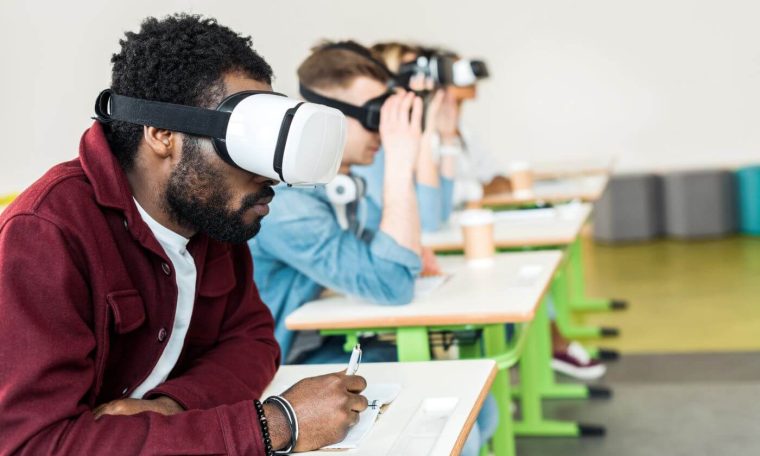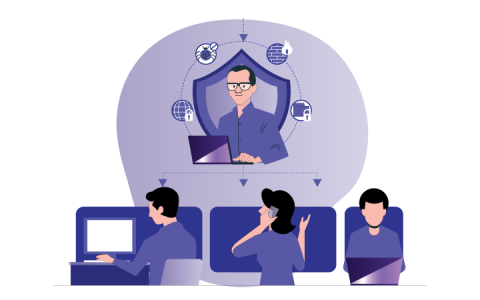
With the introduction of virtual reality in science education, learning has become fun. It allows students to conduct online science experiments in an immersive environment.
This innovative approach of using VR technology in education not only makes science education more accessible but also enhances students’ understanding and enthusiasm for the subject.
Here is how-
Power of Immersion
The power of immersion through virtual reality technology is nothing short of revolutionary.
It is similar to a magical doorway that allows students to step into the virtual world where they can become scientists and experience the wonders of scientific phenomena firsthand.
In a traditional educational setting, students have to learn passively either through textbooks or through video lectures.
Unlinke this limitations, virtual science experiments offers students to immerse themselves in a virtual lab setup or field environment which is the replica of the physical laboratory.
This means by wearing a VR headset, students can find themselves inside a virtual lab that is made up of sterile white walls.
All the sophisticated equipments are present inside with a soft glow of a computer monitor which seems to be real, but the twist it that it is not.
Not only they will be able to see these equipments, they can perform experiments by picking up the virtual test tube, mixing the substances, and witnessing the chemical reactions in the real-time.
Yes, virtual reality makes experimentation more then a chapter in a textbook. In VR experiments, students became the active participants where they can turn dials, change variables, and observe the consequences of their actions.
Such immersion in virtual reality experimentation helps the students to develop a deeper understanding of the complex concepts.
The three-dimensional reality of VR brings depth and tangibility to abstract ideas, making science come alive in a way that traditional methods often struggle to achieve.
Moreover, this immersive experience sparks engagement and enthusiasm among students. Their curiosity is piqued, and their thirst for knowledge is quenched in the most captivating way possible.
Accessibility and Inclusivity
Accessibility and inclusivity are fundamental principles that guide the efforts to provide equal learning opportunities to all students.
However, the traditional educational landscape limits these principles of education which includes limited access to physical laboratories, costly equipments, and extensive resources.
Here is how VR for science education has overcome these challenges-
By democratizing Science Education
With VR science education, students no longer need to attend schools or institutions with well-equipped laboratories to gain hands-on experience.
They can go on their scientific journeys from the comfort of their homes or classrooms, making learning more equitable and accessible than ever before.
Overcoming Resource Constraints
The cost of procuring and maintaining laboratory equipment has often been a deterrent for many educational institutions, particularly those with limited budgets.
VR offers a cost-effective alternative by simulating the laboratory environment, eliminating the need for expensive apparatus and reducing maintenance expenses.
This means that even schools with modest resources can provide their students with enriching scientific experiences.
Geographic Equality
Geographic location should never be a hindrance to learning.
However, in reality the access to quality educational resources can vary widely as it depends on where students live.
VR extends beyond the geographical boundaries, which ensures that students in rural areas or regions with limited access to advanced educational facilities can engage in interactive science experiments with the same ease as their urban counterparts.
Promoting Diversity and Equity in STEM
Inclusivity doesn’t only mean making science education accessible.
Yes, it is also about fostering diversity and equity in STEM fields.
By enabling students from diverse backgrounds to participate in VR science experiments, we are taking significant steps towards a more inclusive scientific community.
This inclusivity encourages students from underrepresented groups to pursue STEM careers and contribute their unique perspectives to the field.
Customized Learning
Students with different learning styles and abilities can adapt the VR environment to suit their needs, creating an inclusive atmosphere that caters to individual learning preferences.
Safety First
Traditional science experiments often involve potentially hazardous chemicals, intricate equipment, and occasionally unpredictable natural events.
In such settings, ensuring the well-being of students is a primary concern. This is where VR steps in as an invaluable tool in education, addressing these safety concerns in a multitude of ways-
Controlled Learning Environments
With VR, students can perform experiments in a meticulously designed and controlled environment.
Educators can create scenarios where students interact with various scientific phenomena in a risk-free space.
Whether it’s conducting experiments with volatile chemicals, simulating high-energy physics, or exploring the effects of natural disasters, students can do so without any real-world risks.
Hazardous Substance Handling
In traditional science education, working with hazardous substances requires strict safety protocols, personal protective equipment, and specialized facilities.
In contrast, VR enables students to handle and experiment with hazardous materials without any of these requirements.
Students can manipulate and interact with these substances in a risk-free digital realm, removing the need for potentially harmful physical exposure.
Mistake-Friendly Learning
In the world of science, making mistakes is a fundamental part of the learning process.
In a VR environment, students are free to experiment, take risks, and make errors without fear of harmful consequences.
This mistake-friendly learning approach fosters a deeper understanding of scientific principles and encourages students to think critically, without the fear of mishandling real-world equipment or substances.
Let’s take a closer look at some examples of VR-enhanced science experiments that are enriching students’ learning experiences:
Molecular Chemistry
With VR technology, students can explore the three-dimensional world of molecules and chemical reactions, allowing them to better understand molecular structures and the principles of chemistry.
Astronomy and Space Exploration
VR simulations can transport students to distant planets, stars, and galaxies, thus, providing an immersive experience of space exploration and celestial phenomena.
Biology and Anatomy
Students can dissect virtual organisms or explore the human body in detail. This allows them to gain a comprehensive understanding of biology and anatomy.
Environmental Science
Virtual field trips within VR laboratory enable students to investigate ecosystems, observe endangered species, and study the impacts of climate change, all from the safety of their classrooms.
Conclusion
To conclude, with VR, laboratory experiences are brought to student’s fingertips.
VR allows budding students and scientists to conducting science experiments in an immersive, accessible and safe environment.
As technology continues to advance, the potential for VR in science education is limitless, it promises a brighter future for students and the scientific community.
Read More:- 5 tips to increase your visibility on Instagram and Media



